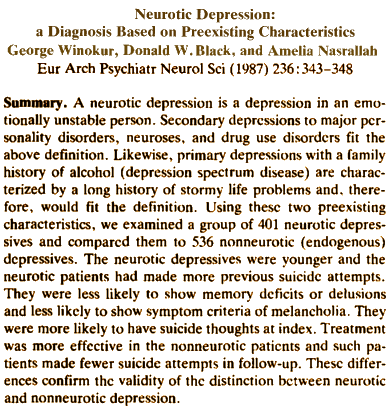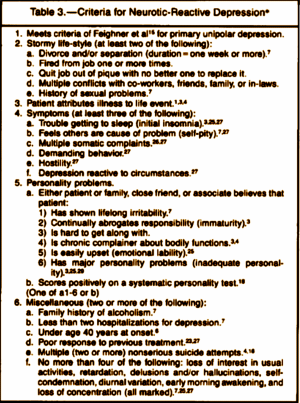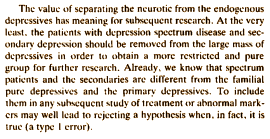Diagnostic criteria for use in psychiatric research
by FEIGHNER, J. P., ROBINS, E., GUZE, S. B., WOODRUFF, R. A., WINOKUR, G. & MONOZ, R.
Archives of General Psychiatry. 1972 26:57-63.This communication presents specific diagnostic criteria for those adult psychiatric illnesses that have been sufficiently validated by precise clinical description, follow-up, and family studies to warrant their use in research as well as in clinical practice. These criteria are not intended as final for any illness. The criteria represent a distillation of our clinical research experience, and of the experiences of others cited in the references. This communication is meant to provide common ground for different research groups so that diagnostic definitions can be emended constructively as further studies are completed. The use of formal diagnostic criteria by a number of groups, regardless of whether their interests are clinical, psychodynamic, pharmacologic, chemical, neuropsychological, or neurophysiological, will result in a solution of the problem of whether patients described by different groups are comparable. This first and crucial taxonomic step should expedite psychiatric investigation. Diagnosis has functions as important in psychiatry as elsewhere in medicine. Psychiatric diagnoses based on studies of natural history permit prediction of course and outcome, allow planning for both immediate and long-term treatment, and make communication possible between psychiatrists and other physicians, as well as among psychiatrists themselves. Such functions are of obvious importance in research. In contrast to the American Psychiatric Association Diagnostic and Statistical Manual of Mental Disorders [DSM-II], in which the diagnostic classification is based upon the "best clinical judgement and experience" of a committee and its consultants, this communication will present a diagnostic classification validated primarily by follow-up and family studies…
The debate about depression wasn’t over in 1980. While the more public discourse focused on the unprovability of the psychodynamic formulations in the DSM [Adolf Meyer] and DSM-II [Freud], there was major opposition to a unitary depression category from many Biological Psychiatrists. I’ve mentioned the opposition by Drs. Bernard Carroll, Don Klein, and others who argued that the depressions called then, Melancholia or Edogenous [Endogenomorphic] Depression, were unique and should remain a separate category [see Dr. Carroll’s 11th hour letter to Sr. Spitzer].
In reading back through the writings of that period, I concluded that there were two roadblocks to making that separation – having "two depressions." The first was insurance. Third party payers were balking at covering the treatment of people whose depression arose from life or mind, which I presume they saw as unhapiness rather than depression. The second block was that Dr. Spitzer et al couldn’t think of a way to define a "neurotic" depression that people wouldn’t assume was the "Depressive Neurosis" of the psychoanalysts – and they wanted them out of the mix. Those speculations, by the way, are my opinion, not provable fact.
It should be noted that the class "neurotic depression," which is one of the most commonly used diagnoses in the standard nomenclature, is not used in the RDC. This term involves too many different meanings to be reliable and valid. Neurotic depression is variously used to mean nonincapacitating, nonpsychotic, nonendogenous, nonrecurring, nonsituational, nonbipolar, due to conflict, or some unspecified combination of all of these features. We believe that each of these features can be better studied separately than by combining them into a single class.
The Validity of Neurotic-Reactive Depression:
New Data and Reappraisal
by George Winokur, MD
Archives of General Psychiatry. 1985 42:1116-1122.A family history of alcoholism can be used as a validating factor in the diagnosis of reactive-neurotic depression. Not only is this true but there are clear data that indicate the presence of positive symptoms that can be used to make the diagnosis. A set of criteria based on previous research is presented for the diagnosis of neurotic-reactive depression. These criteria are based on a clustering of certain symptoms, events, and traits in patients with neurotic-reactive depression. The patients showed stormy life-styles, some specific symptoms, personality abnormalities, presence of life events before the onset of depression, and a family history of alcoholism. They had relatively few hospitalizations for depression and responded poorly to specific antidepressant treatment.


Situational Major Depressive Disorder
by Robert M. A. Hirschfeld, MD; Gerald L. Klerman, MD; Nancy C. Andreasen, MD, PhD; Paula J. Clayton, MD; Martin B. Keller, MD
Archives of General Psychiatry. 1985 42:1109-1114.Fifty-seven patients with situational major depression diagnosed by the Research Diagnostic Criteria were compared with 72 subjects with nonsituational major depression on demographic, clinical, and psychosocial variables. The situational patients tended to be younger and had fewer prior episodes of depression and fewer hospitalizations. No differences were found in categories of life events, in overall clinical picture, in social supports, or in family history.Concluding Remarks
Our results do not support the validity of situational major depressive disorder as a subtype of major depressive disorder. The distinction seems to be more of a reflection of the patient’s age and number of prior episodes. This diagnosis is more often made among first- or second-episode younger patients, and the attribution of the causal role of psychosocial events by the patient and the clinician seem to decrease over time and with subsequent episodes. Nonetheless, there is a clear association of this distinction with the amount of emotional distress experienced by the patient, compared with overall stress. The clinical implications of our findings and those of others are that clinicians should not use the distinction of premorbid Stressors to determine choice of treatment, specifically the exclusion of tricyclic antidepressants…
While I’ve only provided a few of the articles from the period, this was an active and important debate. The opposition to the unitary category, Major Depressive Disorder, was not from the psychoanalysts or psychotherapeutic community, it was from other research oriented psychiatrists. Dr. Winokur was very clear about why:

Sorry, the comment form is closed at this time.